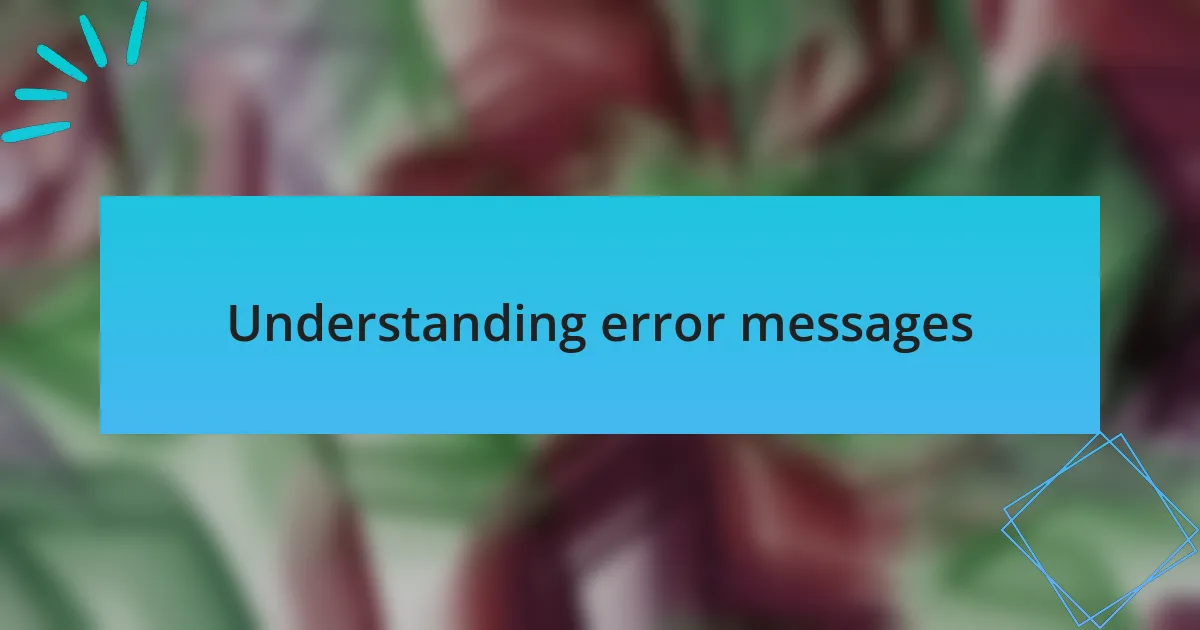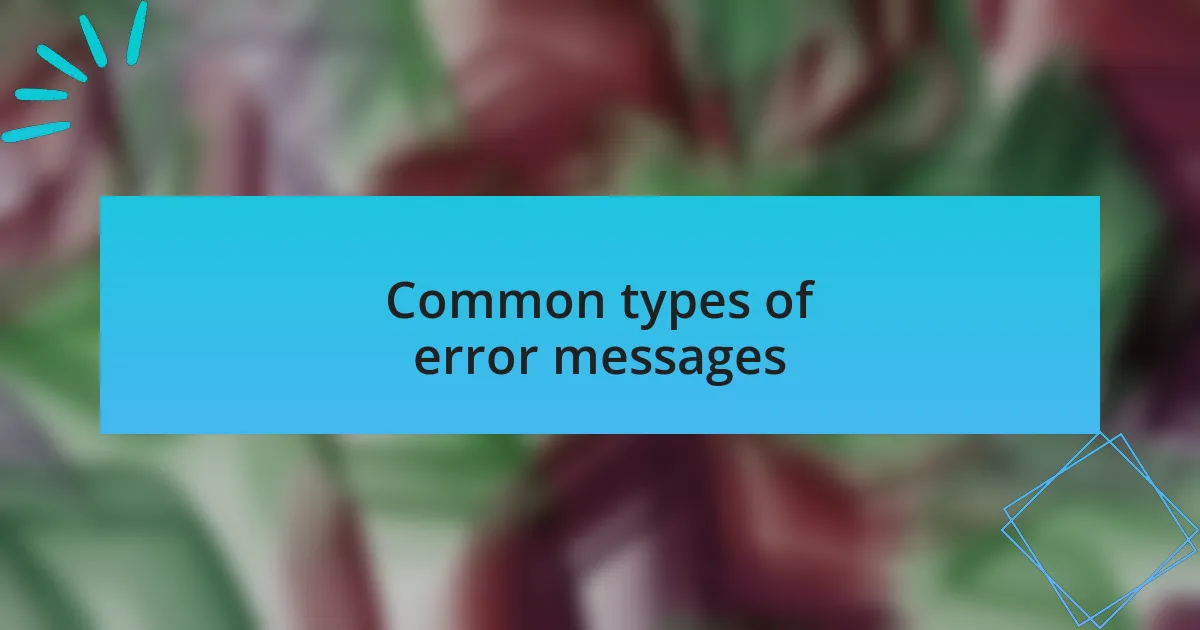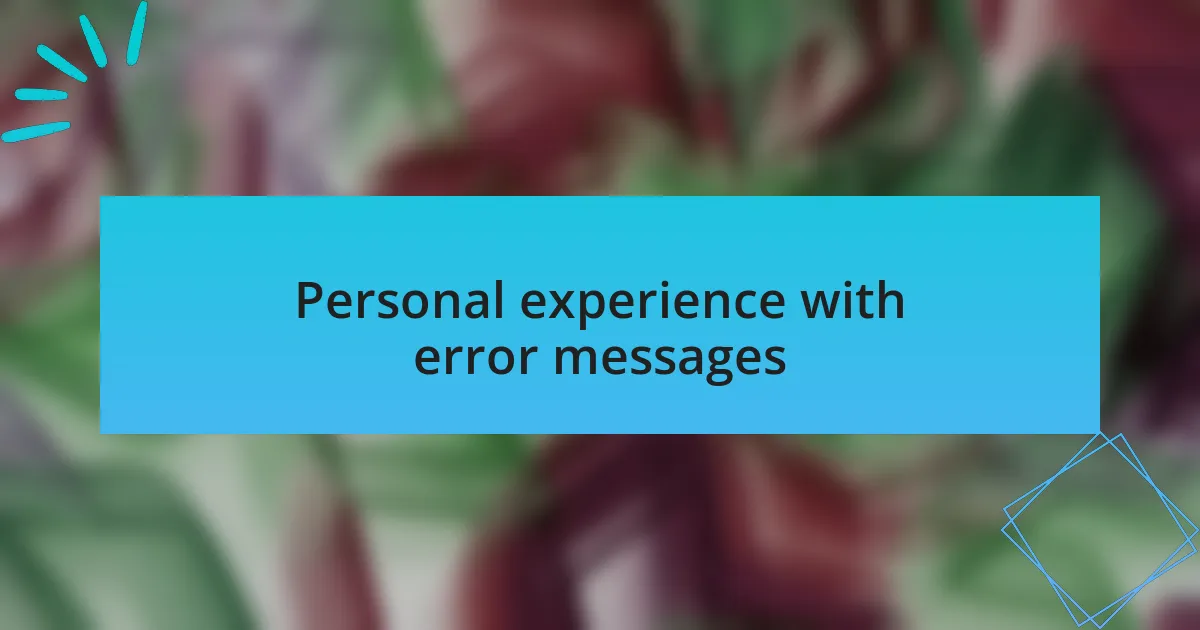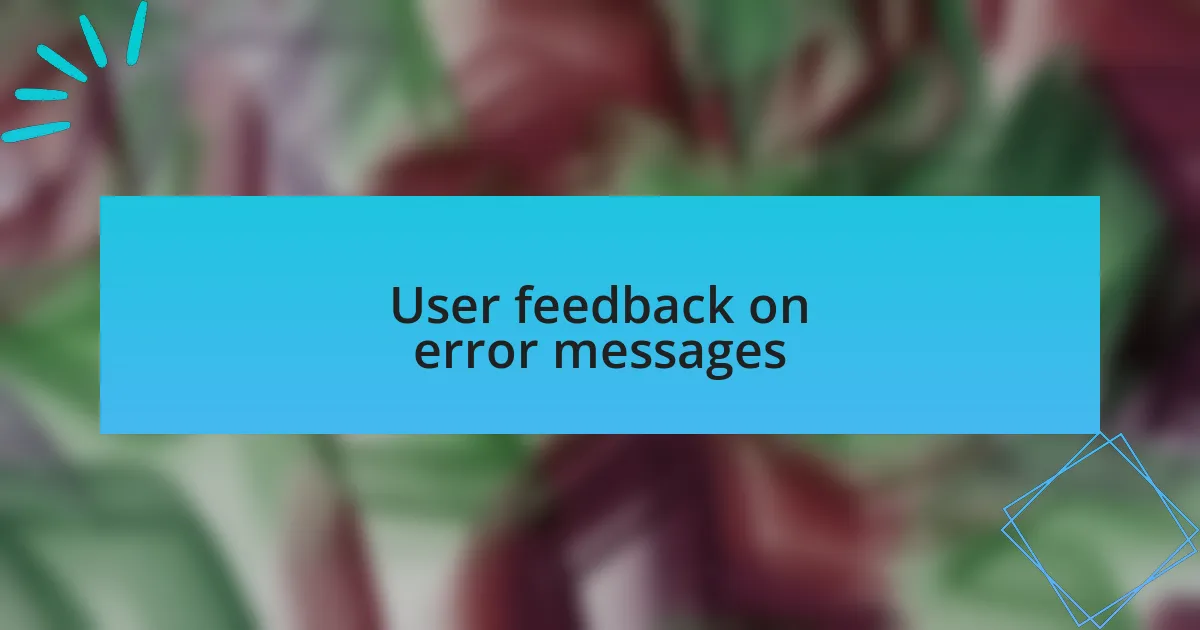Key takeaways:
- Empathy and clarity in error messages can significantly improve user experience, turning frustration into understanding.
- Humorous and friendly tones in error messages help to alleviate users’ concerns and create a positive interaction.
- Real-time feedback for form validation errors enhances user guidance, preventing confusion and promoting smooth interactions.
- Personalized and engaging error messages foster deeper connections between users and brands, elevating their overall experience.

Understanding error messages
Error messages are often the first point of contact users have with your website when something goes awry. From my experience, a well-crafted error message can transform a moment of frustration into one of understanding. Have you ever been on a site when something went wrong and felt completely lost? It’s important that users know they’re not alone in their experience.
I remember encountering a 404 error on a site that I loved. Instead of just a bland message, the page greeted me with a friendly tone and offered suggestions on related content. That moment made me feel valued as a user, rather than just an inconvenience. It’s fascinating to see how a little empathy in design can encourage users to stay engaged rather than bounce away.
Considering the emotional aspect of error messages is crucial. Imagine you’re working late at night, and you hit a wall because of an unclear error prompt. It can lead to confusion and even anger. Therefore, I believe that our goal should always be to provide clarity and a sense of direction. How can we ensure our users leave feeling supported? It starts with being honest about the issue and offering clear, next steps.

Common types of error messages
When we talk about common types of error messages, one of the most notorious is the 404 error. This happens when a page cannot be found, often leaving users scratching their heads. I recall visiting a design agency’s site and encountering this message, but instead of feeling frustrated, I was presented with a playful image and links to popular pages, which made me smile and encouraged me to explore further.
Another type is the 500 Internal Server Error, which can be alarming. It signifies something went wrong on the server side, but what struck me was how one site handled it. Instead of a technical jargon overload, they simply stated, “Oops! We’re experiencing some technical hiccups. Please check back soon.” This approach not only softened the blow but also reassured me that they were on top of the situation. Don’t you think a bit of humor can go a long way in easing frustrating moments?
We’ve also got validation error messages, typically seen when forms are filled out incorrectly. I once filled out a lengthy application only to be met with a vague error message saying, “Please correct the errors.” Talk about disheartening! But then, I came across a site that highlighted the specific fields needing correction in real-time. This proactive feedback made my experience smoother, and I appreciated feeling guided rather than lost. How can we learn from these experiences to improve our own user interactions?

Personal experience with error messages
Encountering error messages can often feel like stumbling over a hidden rock on a smooth path. I remember a time when I attempted to access a design agency’s portfolio, only to hit a 404 error. Instead of annoyance, I was delighted by their creative, humor-infused error page, which suggested I explore their latest blog posts while waiting for the portfolio to return. It turned a potential frustration into a lighthearted moment, showcasing how a little creativity can enhance user experience.
There was another incident that left an impression on me: I was filling out a contact form on a design agency’s site, full of excitement to reach out. When I hit “submit,” an ambiguous validation error popped up, leaving me confused. I took a breath and noticed another site that responded differently. Their real-time feedback pointed out exactly what I needed to fix without overwhelming me with endless technical language. That clarity made all the difference. Have you ever wished a site would just hold your hand during those moments of uncertainty?
On one occasion, I encountered a 500 Internal Server Error while browsing a design site. Admittedly, my first reaction was frustration, but then I noticed their playful approach: “Things are a bit haywire on our end. Don’t worry, we’ll be back soon!” That light-hearted tone disarmed my irritation and reminded me that errors happen. It makes me wonder how adopting a friendly voice in error messages can truly reshape a visitor’s feeling during unforeseen hiccups.

User feedback on error messages
User feedback on error messages often reveals a deeper connection with a brand. I recall a time when I faced a form submission error on a website. Instead of merely stating “Error: Try again,” it creatively asked, “Oh no! Did something go wrong? Let’s fix this together.” That small touch made me feel like I was engaging with a friend rather than a faceless online entity. How often do we overlook the emotional impact of these simple phrases?
Another memorable experience involved a payment error. The message simply read, “Payment failed: Please check your card details.” Honestly, my heart sank. It felt impersonal and left me anxious. In contrast, I’ve seen sites that provide a little pep talk alongside the error: “Uh-oh! It seems like your card might need some TLC. Let’s try again!” That approach made me feel more supported, reducing my frustration and keeping me in a positive mindset.
I also noticed that users react positively when errors are accompanied by helpful suggestions. For instance, a website I frequented displayed a message after a missed login attempt: “Whoops! Did your cat walk on your keyboard? Here’s a link to reset your password.” This blend of humor and genuine assistance transformed what could have been an irritating moment into something relatable. Isn’t it fascinating how tone can turn a potentially negative experience into an opportunity for user engagement?